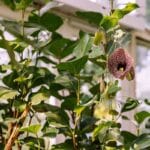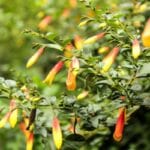Some plants are easy to grow and care for that can serve multiple roles in the landscape. An example of this is the orange trumpet vine, which is often used due to its cascading trumpet-shaped orange flowers.
Laborious maintenance is needed for specific landscape functions, but its beauty makes it all worth it. Keep reading to know more about this beautiful vine and how to incorporate it into a landscape theme.

Botanical Information
The Pyrostegia venusta goes by a variety of common names such as flame vine, cow itch vine, hummingbird vine, golden shower, orange trumpet creeper, flame flower, and flaming trumpet. It is also synonymous with Bignonia ignea and Bignonia venusta. This plant belongs under the Bignoniaceae family, a family of many famous flowering vines including the Campsis radicans.
Spatial Distribution
As native plants of Paraguay and Brazil, these orange trumpet vines are prolific in the tropics and subtropics. In the US, it is suitable to grow trumpet vine in areas belonging to USDA zones 9 through 11. There are some areas under zone 8b wherein this vine was seen flowering.
Growth Habits
The orange trumpet creepers are fast-growing woody vines that spread through different areas. In a span of 2 to 5 years after establishment, the vine extends from 8 to 12 meters high and 1.5 to 2.5 meters wide. Aside from its vast growth, it has tendrils that help it reach places and expand horizons with the assistance of supporting structures. Moreover, it is an evergreen plant which makes it a great addition to vertical landscapes and other landscape functions.
Leaves
The foliage of this flamevine consists of 2 to 3 ovate leaflets, which grow from 4 to 8 cm long and 2 to 4.5 cm wide. They are waxy, oval, and pointed leaflets attached to a slender stem. Also, the leaves change their colors from green to reddish-orange when winter comes.
Flowers
The orange trumpet vine is a common name derived from this vine’s red-orange tubular flowers. It is grown in masses of 15 to 20 florets, with each typically 6 cm long. The best time to see these beautiful orange trumpet vines bloom is during the winter and early spring.
Fruit and Seeds
After the flowers have been pollinated, fruits start to develop. Its fruits are flat and extend for 16 to 33 cm long and 1.2 to 1.6 cm wide. Inside it is the brown winged seeds that are approximately less than 1 cm in diameter.
Growing and Caring Tips
Sun Requirement
As a tropical plant, the flame flower prefers to grow in places where full exposure to the sun is available. However, it also tolerates areas with partial shade. Moreover, remember to give this woody vine ample amounts of sunlight, which is 6 hours of uninterrupted exposure to the full sun, to help in flower production.
Water Trumpet Vines Requirement
Frequent application of average amounts of water is enough to sustain this vine’s growth. Trumpet vine thrives by supplying water at least three times a week. This schedule will depend on the weather wherein frequency is increased as the temperature gets hotter and vice versa.
Temperature and Humidity
The orange trumpet vine prefers hot, humid climates but will thrive in other climates.
Soil Requirement
The flame vine prefers being planted well draining soil, moist, and high in organic matter. Also, loam and sand soils are highly favored. For the soil pH, they are not that picky as they grow in either acidic, basic, or neutral soils.
Fertilizer Requirement
Supplying slow-release complete fertilizers at recommended rates will replenish the nutrients in the soil. Other than that, the flame vine does not necessarily need any special fertilizer. Although, applying phosphorus fertilizers or blooming fertilizers will help the vine develop more flowers when the time comes. It is also important to remember to avoid the application of nitrogen fertilizers before flowering because it will inhibit flower production and induce foliage growth instead.
Maintenance Activities
As a fast-grower, this vine will need space and support to optimize its potential in any landscape. Naturally, the orange trumpet vine will crawl and climb wherever it can. This growth habit is the reason behind giving the vigorous plant structures for anchorages such as stakes, trellises, arbors, fences, and walls.
Aside from providing sturdy infrastructures, pruning is a major maintenance activity for it. They might become unruly so removal of plant parts exceeding its boundaries will help it keep its form. In doing so, the flame vine will keep its aesthetic qualities and accidental competition with other species of plant in the landscape will be avoided.
Furthermore, prune it early in the spring to practically ground level, leaving just a few buds. In return, the production of flowers will be dispersed to other parts aside from the terminal shoots. Also, this will give a better aesthetic for the landscape once the vine enters its flowering stage.
Propagation
There are three ways to reproduce the flame flower. The first is by sowing its seeds. These may be harvested, air-dried for a few hours, then planted in a seedbed or a container.
The second one is with the use of stem cuttings. The process is almost the same as planting seeds. But gathering the needed plant materials may be a bit of a challenge for beginners. In choosing the suitable stems, pick the ones that are not too mature nor too immature. This process will need a keen eye for detail and practice.
Lastly, the layering of suckers is one of the fastest ways to reproduce a new flamin. It takes up less time because most suckers develop their root system while attached to the mother plant. The only thing to do is separate it and plant it in another pot or area, which would require a steady and light hand to prevent damage to the root system.
In all of these methods, the main requirements would be having a good and viable plant material, a well-drained, moist, and porous soil, and an irrigation system for uniform application of water. In cases wherein they are mass-produced, misting or automatic watering systems are in place.
Function In The Landscape
Although an extra effort will be required for upkeep, it still is worth it for the beauty it brings. The flame vine is utilized as a foundation, screen, shade, specimen, and accent in different gardens. To serve as a foundation, shade, or screen plant, support should be supplied to it. For example, they are incorporated with fences, stakes, trellises, and arbors to provide screens and shade in some gardens.
Furthermore, they are also used for vertical landscapes to impart a roughly textured and colorful backdrop that is perfect for photo ops. They are also grown in pots and containers to give color and soften the concrete of homes and buildings, providing a more natural feel.
Potential Harm
The orange trumpet vine is rarely infested by insects, but the most common insect pests are spider mites and scale insects. In terms of plant diseases, the occurrence is extremely low.
On the other hand, the potential harm these native vines may bring to the landscape is solely dependent on the planning and upkeep of the area. When not given enough space and support, the flame vine may take over and disrupt plants nearby just like other vine types.
FAQs
Is orange trumpet vine poisonous?
Yes, the Orange Trumpet Vine (Pyrostegia venusta) is considered toxic if ingested. All parts of the plant contain toxic compounds, and caution should be taken to prevent consumption by humans or animals.
Is the orange trumpet vine invasive?
Yes, it was noted as an invasive weed by the USDA. This is why knowing the right maintenance activities, such as pruning, is important.
Is the orange trumpet vine perennial?
Yes, its average life span is around 2 to 5 years. This range would still vary depending on how the plant is being cared for.
See more: Plants with orange flowers
*image by Wirestock/depositphotos






